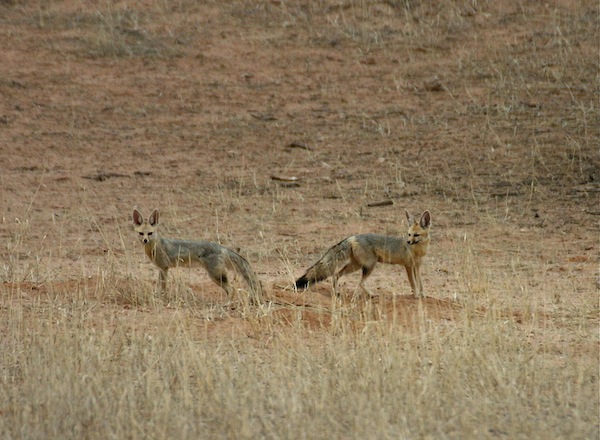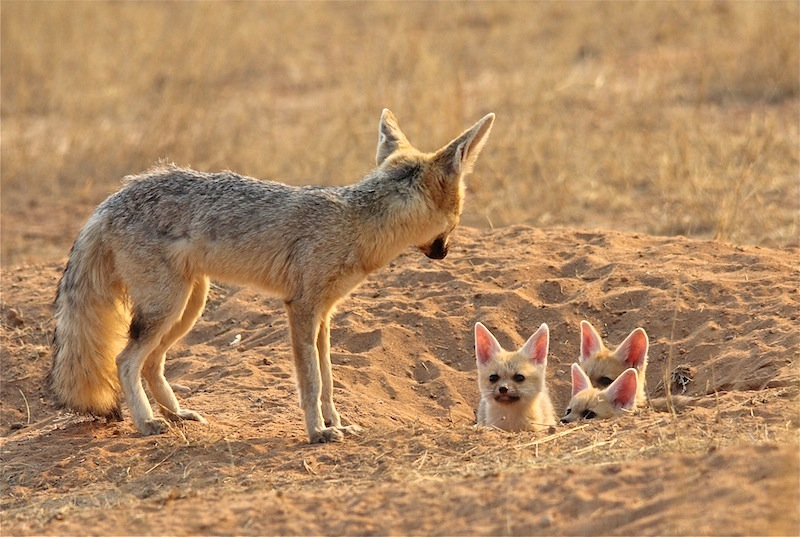Page 1 of 2
Cape Fox
Posted: Thu Jul 18, 2013 7:57 pm
by ExFmem
Cape Fox
(Vulpes chama)
The Cape fox is the only true fox occurring in southern Africa. They are generally common to fairly abundant across much of their range.

(All pics taken in KTP)
Current distribution
The species is widespread in the central and western regions of Southern Africa, reaching to about 15°N in south-western Angola. It occupies mainly arid and semi-arid areas, but in parts, such as the fynbos biome of South Africa’s Western Cape province, the species enters areas receiving higher precipitation and denser vegetation. The species has expanded its range over recent decades to the south-west where it reaches the Atlantic and Indian Ocean coastlines. Expansion through South Africa’s Eastern Cape province has been documented. Status in Swaziland is uncertain, but they may occur in the south- west, as the species occurs in adjacent regions of north-western KwaZulu-Natal; possible occurrence in Lesotho. Previous records of its occurrence in western Zimbabwe and Mozambique have not been substantiated, and it is considered unlikely that these records are valid.
Re: Cape Fox
Posted: Thu Jul 18, 2013 8:03 pm
by ExFmem
Food:
The Cape fox takes a wide range of food items, including small rodents (murids), hares, reptiles, birds, invertebrates and some wild fruits. Rodents were by far the most important mammal prey items; beetles (larvae and adults) and grasshoppers comprised the majority of invertebrate intake.
Birds and reptiles are occasionally included in the diet but these do not appear to be important. The largest wild prey species recorded include hares
(Lepus spp.) and springhares
(Pedetes capensis).

(I did not observe them eating this honeybadger, more using it as a plaything, before taking it into the burrow.)
Although the Cape fox lives in monogamous pairs, foraging is a solitary activity. However, occasionally they may gather in loose groupings to forage at an abundant food source. Foraging is an almost exclusively nocturnal activity, with peaks shortly after sundown and just before dawn. Much prey is obtained by rapid digging with the front paws, often preceded by intensive listening bouts.
Re: Cape Fox
Posted: Thu Jul 18, 2013 8:12 pm
by ExFmem
Reproduction:

Cape foxes breed in monogamous pairs. Males are approximately 5% larger than females.They appear to have overlapping home ranges, especially in areas where food is abundant, although the defended territory is believed to be a limited area around the den in which the female has her litter. Home ranges vary in size from 1.0– 4.6km2 and are likely to vary according to rainfall and food abundance.

The majority of births take place in spring and summer and they have one litter per year.Gestation lasts about 52 days with three to five pups a litter. Young are born in burrows which are dug in sandy soil, or otherwise the adults enlarge those dug by species such as the springhare or aardvark. They have also been known to use crevices, cavities amongst boulder tumbles and, occasionally, dense vegetation.

Although both parents feed the pups, the vixen is the main provider; no helpers are found at dens. Both parents will defend the pups against potential predators. Their habit of abandoning one den for another could avoid accumulation of parasites and confuse potential predators. The male provides for the female for the first and second week after birth and both parents care for the young at the beginning. It is not known how long the male stays with the family group. Pups start foraging at four months, and become independent at 5 months. Sexual maturity is reached by 9 months.
Re: Cape Fox
Posted: Fri Jul 19, 2013 2:39 pm
by Flutterby
What amazing pics ExFmem!!


Re: Cape Fox
Posted: Sat Mar 24, 2018 12:18 pm
by Lisbeth
Urikaruus - KTP - Nov 2017
Re: Cape Fox
Posted: Sat Mar 24, 2018 2:29 pm
by Dindingwe
The Cape Fox is very stylish, I like it very much. Thanks for sharing your pictures. I wish I had seen them during my visits in the Kgalagadi !
The 3 babies that show their head out of the burrow are so cute !
On the 2nd picture of the thread, I would be surprised it is actually a Honey Badger. I can't imagine a Fox killing a Honey Badger, even a young one, as they are very tough animals. Given the size, long hair and stripes, I rather think it is a Striped Polecat.
Re: Cape Fox
Posted: Sat Mar 24, 2018 2:56 pm
by Lisbeth
It is certainly not a honey badger and I am sure that you are right, it's a striped polecat

Thank you for noticing it


(
How superficial we are 
Re: Cape Fox
Posted: Sat Mar 24, 2018 4:36 pm
by Richprins

Are the pics from your recent trip, Lis?
Re: Cape Fox
Posted: Sat Mar 24, 2018 4:50 pm
by Lisbeth
Richprins wrote: ↑Sat Mar 24, 2018 4:36 pm

Are the pics from your recent trip, Lis?
Yes!
I did not remember that also in 2016 the pic of the year was a cape fox


Re: Cape Fox
Posted: Sat Mar 24, 2018 5:22 pm
by Lisbeth
Not bad for the Cape Fox

But they are really cute and difficult to find






